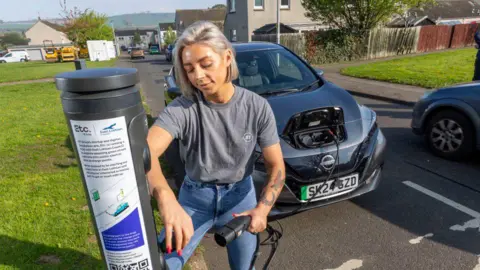In a significant turn of events for electric vehicle (EV) infrastructure in the UK, BT Group has decided to discontinue its ambitious project aimed at transforming street cabinets into EV charging points. Initially heralded as a pioneering initiative to ease the transition from fossil fuel-powered vehicles to electric ones, the project has ended with the completion of just one out of the targeted 60,000 conversions. This outcome raises questions about the feasibility and effectiveness of leveraging existing infrastructure to enhance sustainability efforts.
The street cabinets in question typically serve as housing for telecommunication cables related to phone and broadband services. When BT unveiled this project in April 2024, the company framed it as a unique opportunity to tackle a critical barrier that hinders drivers from shifting to electric alternatives. However, as priorities shift within the organization, the project’s objectives have evolved substantially. BT has announced that it will now concentrate on addressing the “Wi-Fi connectivity challenge surrounding EVs,” rather than expanding its efforts in charging point availability.
The discontinuation of BT’s charging initiative has been met with disappointment from industry observers. Stuart Masson, an automotive expert from the website The Car Expert, remarked to BBC News that while the cancellation is unfortunate, the overall industry narrative remains optimistic. He noted that the proliferation of EV charging stations is accelerating at a pace that surpasses earlier projections. Despite this positive trend, Masson highlighted that many charging points are located in busier areas and not in residential zones where people live, contributing to the frustrations surrounding access to charging options.
Masson did, however, express optimism about BT’s commitment to enhancing Wi-Fi connectivity around charging points. He illustrated the current challenges, citing instances where drivers attempt to log into charging apps only to find themselves unable to connect due to poor signal reception, especially in areas like multi-storey car parks. A targeted approach to improve connectivity could provide users with a much-needed upgrade to their charging experiences.
As BT pivots from its original plan, the future of many of the green cabinets used for the pilot scheme comes into focus. Many of these cabinets are nearing the end of their useful life as BT progresses towards a fibre broadband upgrade. Notably, only one charging point—located in East Lothian—was fully operational throughout the project’s duration. This particular charger is scheduled to be closed in February 2024, a decision reported by the newsletter, The Fast Charge. Currently, it is listed as “out of order” within the Evve Charge app, a platform that helps users locate EV chargers across the UK.
A spokesperson for BT Group shared insights on the trial, noting that the initiative provided crucial information on the hurdles faced by on-street EV drivers. The company aims to zero in on enhancing Wi-Fi solutions rather than continuing with the physically demanding task of converting cabinets into charging stations. The UK government has set an ambitious target to establish 300,000 public charging stations by the year 2030, a statistic underscored by current estimates that indicate 73,334 public chargers are in operation—a 37% increase from the previous year.
The geographic distribution of charging infrastructure remains a critical issue, with nearly a third of existing chargers concentrated in Greater London, as reported by EV charging company Zapmap. This uneven distribution poses challenges for EV adoption in suburban and rural areas, where charging accessibility may be limited. As the UK continues to navigate the balancing act of increasing charging point availability while improving connectivity, BT’s redirection towards Wi-Fi solutions highlights an evolving understanding of what is needed to support the growing EV market.
In summary, as BT Group opts to refocus its efforts away from converting street cabinets into charging points, the implications for the UK’s EV infrastructure landscape remain significant. With only one installation operational and its closure on the horizon, it is clear that the challenges of expanding charging networks will persist, requiring innovative solutions and broader collaboration across the industry. While the path forward may present obstacles, the ongoing push for improved connectivity stands as a hopeful prospect for future EV drivers.



